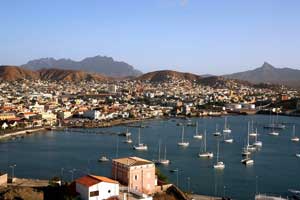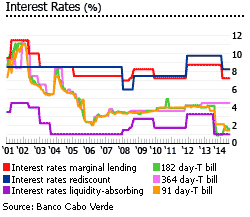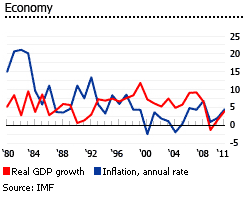Cape Verde leads Sub-Saharan Africa

Good news out of Africa! Cape Verde has emerged as a tourist hotspot. Tourism has been growing at a breakneck pace of 25% annually over the past five years. Tourist arrivals jumped from 45,000 in 1997 to 552,144 in 2013, according to the World Bank.
Having been a former Portuguese colony, it maintains close and special links with Portugal and the Euro zone. Special partnership status has been granted by the EU, and in 2008 Cape Verde joined the World Trade Organization. The country’s democracy is one of Africa’s most stable. It has recently improved its ranking in the Ibrahim Index of African Governance (IIGA) for 2014 and even regained second place from Botswana, second only to Mauritius. The country totaled 76.6 points based on four criteria: Safety and Rule of Law, Participation and Human Rights, Sustainable Economic Opportunity and Human Development. Among the 52 African countries, Cape Verde remains the best among the Portuguese-speaking countries, ahead of Sao Tome and Principe (12), Mozambique (22), Angola (44) and Guinea Bissau (48).
It is also the only African nation to rate a perfect score of "1" on Freedom House’s “Freedom in the World” report, which assesses the level of political freedom and civil liberties around the world.
Cape Verdean property law, which derives from Portuguese colonial rule, is one of the best in the African region, with a US think tank praising the country’s property rights “which are strongly protected by the rule of law in comparison to other countries in the region.”
Cape Verde was officially removed from the United Nations list of Least Developed Countries in December 2007. According to the World Bank, “Good governance, sound macroeconomic management, trade openness and increased integration into the global economy, as well as the adoption of effective social development policies underpinned an impressive development trajectory.”
The average life expectancy (71 years) is the highest in sub-Saharan Africa. Infant and maternal mortality rates have been falling. The country is in the “medium human development” category, ranking 123rd out of 187 countries in the UNDP’s 2014 Human Development Index (HDI). Education outcomes are also impressive relative to the rest of sub-Saharan Africa. The adult literacy rate stands at 87%, although gender gaps persist. Cape Verde is the only African country expected to meet almost all of the Millennium Development Goals by 2015.
As of writing, there have been no recorded cases of Ebola in Cape Verde.
Tourism is booming
Sal, known as “the sunniest island” in Cape Verde, received majority of the tourists in 2014. The island’s tourism sector is expected to further grow in the coming years as foreign investment inflows increase with the commencement of Hilton Group’s hotel construction in Santa Maria, south of Sal.
The first Cape Verde Hilton hotel, due for open in March 2016, will have 240 rooms including 21 suites, one of which will be a presidential suite with a total area of 250 sq.m., three restaurants, a 1,200 sq.m. gym, a business centre and casino.

Property hotspot
Foreign investors continue to be lured by the Cape Verdean property market as bright prospects for the island group remain.
The island of Sal, apart from being the top tourist destination, is also the archipelago’s tourism hub. Sal has the longest runways in Africa, is undergoing a large amount of infrastructurework, ranging from roads to luxury developments.
Boa Vista island now has around 3,000 hotel rooms, similar to Sal, and most of them in the five star category. Cape Verde has overtaken Gambia as the most popular West African vacation choice. Unlike some other countries in the region there is hardly any incidence of malaria, the climate is consistent year-round, varying from 22 to 30 degrees celsius, there is (comparatively) little poverty and there is no political or religious strife, according to CAPA Centre for Aviation.
Efforts are also being made to encourage vacationers to visit other islands, which include São Vicente with its lively capital Mindelo, the hilly and scenically attractive Santo Antão and the volcanic island of Fogo. São Vicente has seen five new hotels in the past year, immediately followed by Santo Antão and Maio with three and four respectively.
While the capital city, Praia, on Santiago Island, is not yet considered as a top destination, the island contains a World Heritage Site and beach facilities are being improved. In mid-2000s, a new airport was also built in the capital to accommodate the influx of travelers, both business and leisure.
The Homes for All Program
Cape Verde has been keen to use the fruits of tourist development to pursue social goals, drawing up a series of measures to promote social housing across the country. In 2009 it formed the “Home for All” Program to reduce the national housing deficit, which now stands at 40,776 dwellings in terms of quantity and 66,013 dwellings in terms of quality.
Subprograms include the Habitar CV Program, which aims to build about 8,496 housing units; the Pro Habitar program. to build at about 1,000 homes in rural areas; and Reabilitar to rehabilitate approximately 16,000 households.
Strong economic growth
Growth in real gross domestic product (GDP) per capita averaged 7.1% between 2005 and 2008, well above the average for sub-Saharan Africa. From 2002 to 2010, the national poverty headcount rate dropped from 37% to 27%, while the extreme-poverty rate dropped from 21% to 12%.

Cape Verde was not exempt from the global financial crises. Real GDP growth at 9.2% in 2007 dropped to -1.3% in 2009, recovered modestly to attain real growth of 4% in 2011 and has slowed again since. GDP growth is estimated at 1% for 2014 and is expected to pick up modestly in 2015, projected at 3%.
Responding to weak economic growth, interest rates were cut in March 2014. In August 2014 The Bank of Cabo Verde kept its interest rate on marginal lending at 7.25% for the sixth straight month, and the rediscount rate is 8.25%. A year ago, the interest rate was 9.75%, the rediscount rate stood at 8.75%.
Public sector debt increased by about 9% in 2013 on the back of the government’s increased use of domestic debt to finance cash needs to compensate for delayed budget support disbursements, according to the central bank.
Having remained stagnant throughout 2013, loans to non-financial corporations and individuals experienced a year-on-year growth of 1.2% in December.
Credit to the economy grew slightly, from 1.2% in December 2013 to 1.6% in March 2014, mainly driven by growth in private loans for construction and/or purchase of homes, to some extent promoted by the Casa para Todos (Homes for All) program.
Ebola Outbreak
The Cape Verdean government prohibits individuals from Ebola-hit areas entering the country. The government has also suspended trips by official delegations to regions affected by the Ebola outbreak, as well as discouraged Cape Verdean residents from traveling. Domestic surveillance and inspections have been reinforced, and awareness-raising campaigns intensified.

“We are controlling all international ports and airports," said Prime Minister José Maria Neves. "We have mobilized the means to do so and trained some 150 health-sector agents and police officers, and set up an awareness-raising campaign aimed at all residents in the country regarding the Ebola epidemic.”
Meanwhile, the International Monetary Fund (IMF) has cut its forecast for economic growth in sub-Saharan Africa this year to 5% from 5.5%, due in part to “economic spillovers starting to materialize” from the outbreak.